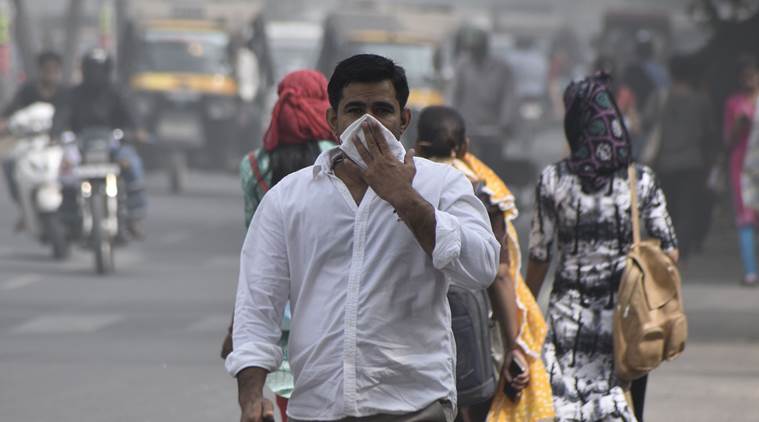 Further, at both sites, the average daily dose of trace elements through inhalation for children was “two times higher than for adults,” said the study. (Express Photo/Manoj Kumar/File)
Further, at both sites, the average daily dose of trace elements through inhalation for children was “two times higher than for adults,” said the study. (Express Photo/Manoj Kumar/File)
Living close to main roads in New Delhi may increase chances of “lung cancer mortality” due to the inhalation of particulate matter that contains trace elements such as chromium and nickel, a new study published in March has found. According to the study, the excess cancer risk (ECR) through trace elements in the air was calculated to be “13-16 times higher than the safe limit for children,” and in the “tolerable limit” for adults.
The study, “Chemical characterisation and quantitative assessment of source-specific health risk of trace elements in PM 1 at a road site of Delhi, India” was published in March 2018 in the journal Environmental Science and Pollution Research. It was conducted by scientists of IIT Delhi and IIT Kanpur who studied the concentration of submicron aerosols or PM 1 collected between November 2009 and March 2010. The study looked at the concentration of PM 1 at two sites – one on the road and another at an elevated site – near the IIT Delhi campus and found that in winters 83 per cent of PM 2.5 was composed of PM 1. It also said that this indicated the “dominance of combustion activity-generated particles.”
While PM 2.5 particles have a diameter lesser than 2.5 microns, the diameter of PM 1 particles is less than 1 micron. Particulate matter is lethal, fine dust that clogs lungs.
The study analysed the contents of PM 1 particles and calculated the excess cancer risk (ECR) through inhalation. ECR is estimated in terms of the incremental probability of developing cancer over a lifetime through exposure to potential carcinogens. The range for ECR is as per recommendations of the United States Environmental Protection Agency.
Researchers found that the ECR for chromium and nickel was in the “tolerable limit (10-4)” for adults, but “13-16 times higher than the safe limit (10?6) for children. The ECR of nickel for adults and children was 102, and “14 times higher” at the road site compared to the elevated site. For lead, the ECR was found to be “16% higher than higher at elevated site compared to road site for both adults and children.”
The study looked at the average daily dose (ADD) of six trace metals – chromium, copper, manganese, nickel, lead and zinc. Among them, the ADD for nickel “was found to be highest…for children and adults” and was 11 times higher at the road, than at the elevated site.
Further, at both sites, the average daily dose of trace elements through inhalation for children was “two times higher than for adults,” said the study.
The study also looked at potential sources of the studied elements. It found that “high emissions of nitrogen oxides from fuel or oil combustion could be the possible reason for high nitrate than sulfate.” While road dust – containing iron and zinc – could be predominantly “from brake/tire wear of vehicles”. Copper and leader could be a result of “vehicular emissions in urban roads and high traffic volume.” Potassium, on the other hand, could be a result of biomass burning, it said.
The study said, “It should be noted that the potential health risk due to long-term exposure to vehicle exhaust emissions and re-suspended road dust and emissions from wear and tear of vehicle parts is a threat to pedestrians, people working in commercial establishments near roads, and residents living nearby.”
“Overall, the observed ECR values far exceed the acceptable level and it is of great concern to inhabitants (both adults and children) of the capital of India. An increased lung cancer mortality may occur among population residing close to the roadside in Delhi due to inhalation of particulate-bound trace elements,” the study concluded.
The study only calculated ECR of lead, chromium and nickel “out of 11 trace elements which are well-known carcinogens that pose risk to inhalation pathway.”
The study has been conducted by Jai Prakash, Tarachand Lohia, Gazala Habib and Sanjay K Gupta of IIT Delhi’s department of civil engineering and Anil K. Mandariya and Tarun Gupta of IIT Kanpur’s department of civil engineering.